A democratic school... certainly sounds different. And exciting. I wonder what this actually means. Well, I’m going to find out soon, because I’m spending the next two days at FREIWÄRTS.
In the lobby, I quickly take off my shoes and put on my slippers – that’s how things are done here – and I’m already smack dab in the middle of the morning circle, which kicks off the day’s activities. This is where the group discusses everything that’s going on – who’s here today, who’s absent? Who’s turn is it to clean up the coatroom? The children find out that the school now offers a ping-pong class, where they can learn how to serve and smash. While the older students get through the morning circle quickly, the elementary school students take longer. This is because they fool around a lot, as high-school student Mona[1], who makes friends with me right at the beginning, explains.
Shortly before half past nine, the children gather for the first class of the day. Erika, the principal and founder of the school, walks through the rooms and looks in every corner of the playground until she has gotten all of the children together. Some of them can’t tell time yet, so they don’t exactly know when the period starts. Others, on the other hand, are so immersed in their game that they simply lose track of time. Erica also has to find me as well, because I mixed up the rooms and am sitting somewhere else.
Singing together is the first thing on the agenda in the morning. Together with the children and Erika, I belt out a song by German pop singer Lena that I don’t know, but that one of the children requested we sing. It doesn’t matter that I can’t really sing, Erika assures me. The most important thing is that we have fun. I give it my all. The girl to my left looks at me from time to time to see if I’m really singing along. “Why is the title of the song ‘Thank You’? Why is Lena thanking people for the setbacks she’s faced?” asks Erika when the song ends. The children think about it. “Maybe because they have made her stronger? That’s what she sings in the song: I am stronger now,” says one girl. Someone else nods in agreement.
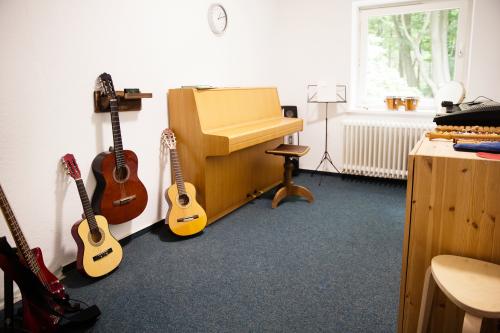
The World of Numbers
Immediately after singing, the “World of Numbers” is next on the day’s agenda. Today, only little Mia is taking part; the others are sick or would rather play with their friends, who they won’t see for a while due to the upcoming school break. Mia draws a number wall on the board – a pyramid made of individual bricks, each of which have a number inside. The sum of two adjacent bricks adds up to the value of the brick that is placed above them. Thanks to the number wall and similar exercises, Mia gains a better understanding of numbers and learns to add in a playful way. The same is true for “Letter Land,” which takes place on Tuesdays, except that the focus there is on letters and first words. While the student and teacher consider whether it is possible to build a number wall from the top down (unlike in the real world, it is indeed possible, although much more difficult), another girl joins in who would also like to participate. Karina, the teacher, tells them a little trick they can use when adding difficult numbers together: “If you want to add a 9 and a 5, you can just imagine that the 9 is a 10. 10 plus 5 equals 15. Then you just subtract 1 from the total, because you actually had a 9 and not a 10.” Clever.
But that’s not all the two girls are learning today. Karina explains the equal sign that real mathematicians use: “You can think of it like a scale; the same thing has to be on the right and on the left.” Roman numerals also come up and Mia discovers that she is a 1001 (M = 1000, I = 1). I realize that despite the many letters in my first name, I’m only a 500, because only the D is used in Roman numeral notation – too bad.
You Better Be Sitting, When You Start Whittling!
Three or four classes are held each day at FREIWÄRTS, and the weekly schedule constantly changes – sometimes new classes that someone has requested are approved by the weekly school assembly, while others disappear from the schedule because no one is interested in them anymore. At the moment, “whittling” is quite popular, and the children are free to whittle anything that comes to mind. Often, they don’t even know what that will be in the end. Just like I don’t know how this article will turn out while I’m writing it. For those in need of some inspiration, 50 cards are available with different ideas – including a spoon, a small spinning top, or a coat hook, for example – and instructions on how to carve them. But the most important rule is that you better be sitting, when you start whittling! And always whittle away from the body.
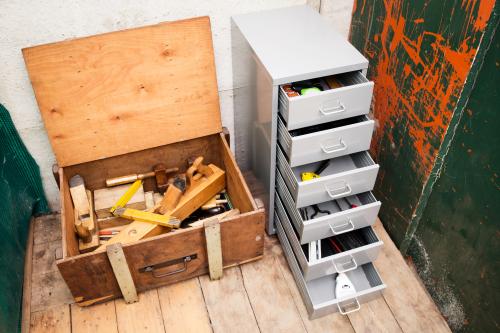
The boys initiated the whittling class, submitted a request, and it was subsequently approved by the school assembly. The same goes for “experimenting” or “Access Bars,” a technique of touching specific points on the head to relieve stress, for example. The “Bars” are offered by one student who wants to introduce others to this wellness practice. But this class is no longer that popular and will probably be replaced with something else soon. Spanish, on the other hand, is currently all the rage, so the school offers three sessions a week for beginners and more advanced students. The English instructor comes to the school on Fridays and primarily gives one-on-one lessons –the students have all found that this works best for them in English.
When it comes to the selection of classes, it’s always based on the children’s needs. The school offers what they’re interested in. Because of this, previous classes have included a programming class, a joke-telling class, a drawing and painting class, a Rubik’s Cube class, and a class on general knowledge. The instructors don’t have to fulfill a traditional teaching role, they are simply on hand to provide support – and the children teach themselves. They can also lead a class of their own, and in fact, this is something the school emphasizes. Anyone that has a skill is encouraged to pass on their knowledge to the others. It’s like how people used to barter before there was money – if you have something I want, maybe I can offer you something else in return later. It’s give and take. The way a unit progresses isn’t predetermined, it evolves and changes with the participants, their moods, their current level of interest. Instructors see what happens during the half hour or full hour. The ideas for classes don’t come from them either, but from the children, although sometimes a conversation between teacher and students may lead them to discover common interests, which then leads to a new class. Everyone who wants to, learns together; the school doesn’t have different grade levels.
What if someone wants to learn Japanese, I ask Karina. Then that person would have to submit a proposal to the school assembly. If the class gets enough votes, then everyone starts thinking about ways to make it happen. Several options are available – either the school already has a student who speaks Japanese and can teach it to the others. Or the group opts for educational software that’s then installed on the school’s computers. Or another alternative would be that the school hires someone to teach the language.
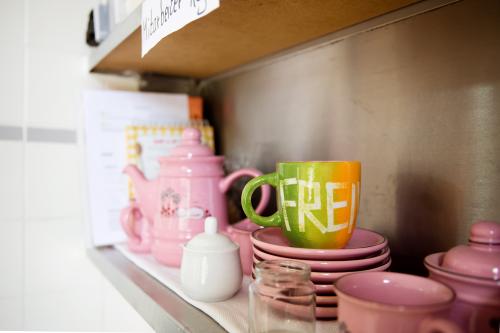
Forest, Mushroom, Frog – Sounds Like Learning
I take a look at the schedule for the rest of the week and see a class named “forest.” That sounds interesting and I ask about it. Once a week, the adults and children head out into the woods. The school is located on the outskirts of Hamburg and is surrounded by the Sachsenwald forest. Together, the group takes a closer look at whatever they encounter there – sometimes it’s frogs. Other times mushrooms – an excellent reason to run to grandma’s house after school and check out the book about mushrooms she has on her bookshelf. And then bring it to school the next day so everyone can learn about the types of mushrooms that grow in the local forests. Once, however, the children found garbage in the forest, discarded old appliances that were just lying around and had no business being there. Upon their return, they all worked together to find out who they could contact about this, then called them and resolved the matter – and once again learned something new in the process. And eventually the trash was removed.
Learning happens here on a voluntary basis. And that’s why it works so well. Each child decides for themselves what they want to learn. This also makes them really motivated in the process. On the one hand, the children learn from each other – if someone sees that the schoolmate next to him can program cool stuff on the computer, he definitely wants to learn how to do it, too. Maybe he already has his own ideas about what he could do with the app. So, he gets the person sitting next to him to explain everything to him. This makes learning even more effective – when someone of a similar age or in a similar situation explains something to you.

First, the children learn independently, for example by flying a paper airplane and thus discovering that there is such a thing as gravity. Later, when it comes time to take exams, things become more structured. In addition to German, English, and math, which are mandatory, students choose specific subjects or areas of focus in which they would like to earn their diploma and register for the corresponding exam courses. Since the school has ten grade levels, they can earn two official German secondary school diplomas here – the ESA and MSA. ESA stands for the first general secondary school diploma in German, while MSA refers to an intermediate secondary school diploma.
The preparatory classes are held in groups, and in this case as well, students learn according to their needs and at their own pace. At the end of each day, the children are responsible for independently recapping all the new things they learned that day. They are assigned a mentor who guides them on their way to graduation and offers them assistance and support. The mentors are usually chosen by the students, because you learn most effectively when you are guided by someone you like and with whom you develop a certain bond.
In addition to the mentoring sessions, the children help each other. But they also do this at every other opportunity as well. I enter the large student lounge and see some young children playing chess. An older girl is with them; she explains something to the little ones now and then. A younger girl comes up to me and asks me what my favorite animal is completely out of the blue. I pause and think about it for a moment. Dog! When I ask her the same question, I learn that her favorite animal is an elephant. “Why?” I want to know, but by then she’s already running away because she’s been called to play.
More Democracy for the Kids
So why does FREIWÄRTS call itself a “democratic school” anyway? This is because the children have a significant say in the decision-making process here. On the one hand, everyone in the school assembly decides on how the school uses part of its budget – like what to buy or what materials are needed for a class, for example. The school assembly also discusses rules, puts them in place, adjusts them if necessary, and sometimes even repeals them. The children not only choose the classes that the school offers but are also free to decide whether they want to participate themselves on a particular day. If they don’t feel like doing math today, they can take a walk around the playground instead and ponder their own thoughts, or retreat to a cozy corner and spend some time alone, or play around with the others. The choice is theirs. I see some kids running around outside barefoot and automatically think “brrr!” After all, it’s the end of September, and I’ve already gotten my scarf and knit hat out of the closet. On the other hand, if they don’t mind it or even actually enjoy it, why not...
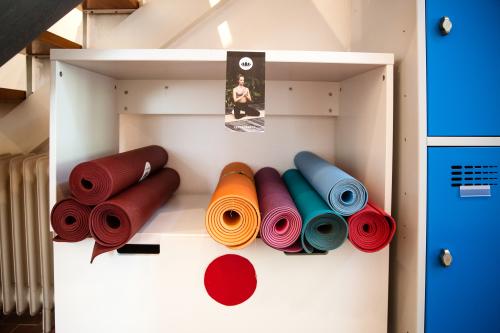
Does democratic mean everyone can do whatever they want? Not at all. In fact, FREIWÄRTS has more rules than other schools. The difference is, here the rules were created according to the needs of the school community during a meeting of the school assembly. Individuals are free to make their own choices only as long as their actions don’t affect others. If this does occur, those involved look for a solution. Democracy also requires that teachers and students treat each other as equals. That’s why these two terms are not used here at all. The adults refer to “people” when they mean the children. The word child, in fact, is judgmental – and indicates a hierarchy, just as the term student does. When in fact, there are only big people and small people. The teachers refer to themselves as “collaborators.” And treating each other as equals also means that everyone is on a first-name basis.
Even if the teachers do not refer to themselves as such, they have indeed undergone teacher training or training equivalent to the second state examination as prescribed by the state of Schleswig-Holstein’s Ministry of Education – as is also required at regular schools. The difference is that FREIWÄRTS staff are extremely interested in alternative learning methods and, during their teacher training, wanted to know if there was more to it than what they could expect to find at mainstream schools. Whether there may yet be a form of education that takes intrinsically motivated learning more into account. Karina discovered FREIWÄRTS during her search for alternatives and implements what fits her idea of learning here. Despite all its freedoms, the school itself also has its place in our school system because it must meet the requirements set by the Ministry. Just like everywhere else, the children here are expected to possess a precisely defined level of knowledge at a certain age – and they do. Each student’s learning progress is documented by the teachers.
Beam me up, Smarty!
After a few hours at FREIWÄRTS, I notice that something is different here. The atmosphere is completely different from the places I usually spend my time. At first, I’m not exactly sure why that is. “Say, I don’t see anyone looking at their phone here,” I comment to a teacher. “How come?” He explains to me that the children hand in their smartphones before school starts. “We don’t want anyone beaming themselves away here – interacting with each other in person is important.” And what a difference it makes! Whether at work, around town, or even while spending time with friends and family, almost every interaction these days is disrupted by someone looking at their cell phone – the notorious “I’ll just text back really quick” syndrome. Everyone’s mind is constantly in a parallel world. Only when things are different do I fully realize how refreshing it is. And no one seems to miss their magical little device, either. That’s why I simply leave it in my bag when I’m not busy and don’t know what to do next. “Are you bored?” a little girl asks me as I stand a bit lost at the entrance, looking out the window. “No, no, I’m just waiting for the English teacher,” I say, explaining myself. After a brief pause, however, I add, “but you’re right, I’m a little bored, too.” Luckily, the English teacher actually does come by and takes me to her listening comprehension class.
But something else is different about this school. It’s the way people treat each other here. This is because FREIWÄRTS is committed to using “nonviolent communication.” In this case, the word “violent” doesn’t just refer to physical violence – you can inflict violence on your counterpart in different ways, such as through words, but also through actions that you may not have meant this way. Marshall Rosenberg, the psychologist who coined the term nonviolent communication, assumed, among other things, that there is a need behind every action that isn’t good for an individual or the community. That’s why punishments in response to “misbehavior” don’t solve the problem; the need doesn’t just disappear afterward. Sooner or later, it is bound to reappear elsewhere.
The Circle of Trust
This is the reason that people don’t avoid disagreements at FREIWÄRTS; on the contrary, they offer an opportunity to change things for the better. And this school, just like everywhere else where different individuals with different personalities and different needs come together, has its fair share of conflicts. First, the parties involved try to solve the problem among themselves. If this isn’t successful, someone else gets involved, a mediator, who once again assesses the situation from a different perspective. If this, too, is unsuccessful, the parties involved are invited to the circle of trust. Today this is taking place in the “nameless room.” The children, who are new, are afraid of having this conversation, because they expect that it will be about finding who’s to blame. If they’ve “done something wrong,” a reprimand is sure to follow. But that’s not the goal of the circle of trust at all. To signal this, participants actually sit in a circle – there’s no hierarchy.
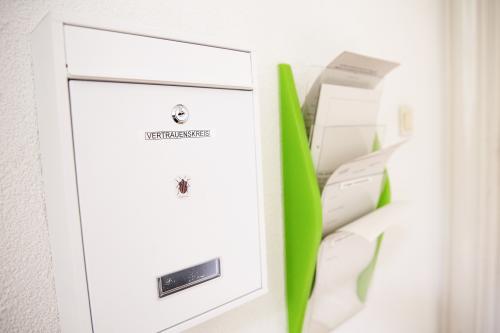
Here, participants don’t evaluate, but instead observe in order to get to the bottom of what really happened. In the next step, the little person or the collaborator tries to determine the feeling associated with the event. This isn’t always easy, because people are often unaware of their feelings. “I didn’t like it when you pushed me,” for example, isn’t a feeling at all. Cards are available to help the participants articulate their feelings. The cards have pictures depicting different emotions on them for the very youngest participants. The older ones find terms written on them like “shocked,” “saddened,” or “hurt” to serve as an aid. Next, the person identifies the associated need, such as “care,” “love,” “closeness,” or “support,” and makes a request: what will it take to have my needs met? The collaborators who participate in the circle of trust support the children in making this request.
Disagreements Are Great
Circles of trust take place almost every day at FREIWÄRTS. The results of the conversations are always amazing. After all, if you dig a little deeper and get beneath the surface, it becomes clear that a problem was often about something completely different than what you thought. In addition, children often develop very different strategies for coping with conflicts than adults.
One case involved a little boy who kept bothering everyone around him. This eventually upset the others, of course, and so a circle of trust was convened. The conversation revealed that the boy always messed with the others when he was hungry. This was something no one expected. And suddenly, the others understood where he was coming from. “Sure, when I’m hungry, I feel the same way you do,” were the responses. The result of the circle of trust was that an emergency snack was introduced, which can be found in the kitchen – just in case.
In another incident, a child accidentally broke a playhouse that belonged to someone else. The solution to this unfortunate situation was not to replace the item. It was much more important that people were aware of the owner of the toy’s sadness – the playhouse was very special to her because it had been a gift from her grandparents, who lived far away. Recognizing her sense of loss turned out to be much more important than getting her a new playhouse.
A solution was also found for the creative space that is currently off limits. This room is a kind of arts and crafts room where the kids can find everything they need to work on projects that initially take shape in their heads – jewelry beads, acrylic paints, a hot glue gun, a sewing machine for sewing doll clothes, as well as many other things in the countless drawers and compartments that I can’t see right now as I stroll through the room. Here, students make musical instruments from the simplest of materials or carry out upcycling projects – turning old, useless things into something completely new that can be used again. I had to sneak in, because the room is actually not open for the students to use because whoever used it last didn’t clean up when they were finished. The idea is for the children to realize that something didn’t go according to the rules in this case. Now the students have sat down with an instructor and come up with a solution to solve the problem: in addition to the introduction to the room that all new users have received so far, they will practice cleaning it up together a few times. The children came up with this idea themselves and are eager to try it out as soon as the room is open again.
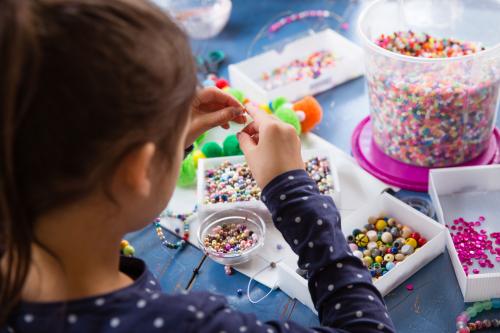
A Page Out of FREIWÄRTS’ Book
I’m genuinely impressed by the kind of communication that is quite commonplace here. How much pain would we adults save ourselves if we could communicate our needs in a clear and straightforward manner, if we treated each other with consideration and as equals, no matter what their background? Whether at work or in relationships with others – how many problems arise because we don’t talk to each other effectively, how many people are unhappy because of this? Everyone can take steps to improve, of course. But anyone who has tried knows what a long and difficult process it is. But if you practice something like this every day, as they do here at this school, how much easier will adult life be later on?
I ask Erika how the children cope when they meet people from outside the school who have never heard of nonviolent communication and do not know or understand much of what is taken for granted here. “The children who grow up here are like a plant that is well cared for,” she says. “This plant develops a solid stem, is stable, and can withstand life’s adversities well.” I get the impression that socially competent individuals are being molded here who have learned to get along well in the community. And in my view, this is what really matters.
But the voluntary approach is also a model that could easily be adopted later in life, for example in one’s career. It has long been proven that people who are given freedom and can use their strengths in their job enjoy their work and – here’s the kicker – are more productive. There aren’t that many employers that have realized this yet, but an education at FREIWÄRTS could be one of the first steps in achieving a mindset shift in this regard.
“How do the children who want to graduate from high school and attend university manage later on?” I ask Erika. “They have gaps in their knowledge,” she admits. “But – and this is the crucial thing – when they decide to take the final exams to graduate from high school and earn a spot at a university, they are highly motivated. And then they also succeed.”
Clean-Up Time
12:30 p.m. Time to clean up! In half an hour, the first parents will arrive to pick up their children, and by then everything should be spotless. After all, nobody cleans up after you when you’re older either. The children grab hand brushes and dustpans, clearing away clippings and crumbs. Although – not all the children. Each room has a small team responsible for it. How exactly to clean the room up is written on the poster on the door, for the smaller children in the form of a pictogram. After cleaning up, the inspection team, which, like the clean-up team, is formed week by week, comes to check if everything is okay. If someone is absent, a replacement is found during the morning circle. This rotating system works quite well, and the best thing about it is that in the third week you are off duty and don’t have to worry about anything.
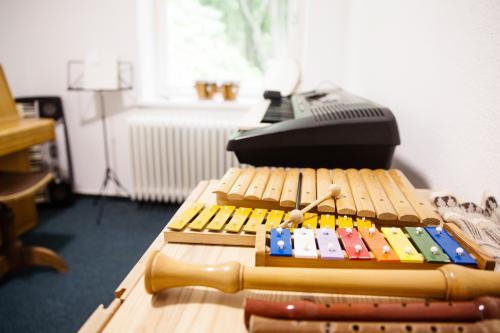
At 2 p.m., the five collaborators hold their team meeting. Everyone reviews the day together, resolves unanswered questions, discusses conflicts and the effect they have on the community, and schedules the circles of trust for the following day. At the same time, the parents have begun to arrive, but not all of them are there to pick up their children.
The Parents Are Also on Board
A parents’ initiative has recently come together to make the school accessible. A professional mason is involved – which is demonstrated to me by the impressively designed wheelchair ramp at the back of the building. “The parents are also contributing to the effort,” explains John, who has just arrived holding his youngest in his right hand and a shovel in his left. “The parents are part of the community, too,” he says. “And are active in a number of groups. For example, one group is responsible for the grounds. There’s also a cleaning task force.” I learn from him that there are three main reasons why parents send their children to a democratic school: either the parents themselves had bad experiences at school in the past. Or their children didn’t handle the rigid system at a normal school well. Or the parents are simply fans of the idea behind democratic schools.
He often must do a lot of convincing among his relatives and acquaintances, because of course many who went through the conventional school system are skeptical at first. The question of whether the FREIWÄRTS children could ever amount to anything comes up again and again. “Do they have to amount to something?” counters John. In his view, there will be people here, just like everywhere else, who leave school without graduating. But on the other hand, most of them will lead a fulfilled life afterwards because they at least had the opportunity to discover where their strengths lie – completely free of the pressure of competition, without grades, and without always comparing themselves to others. “Here, the children aren’t compared to each other; they complement each other.”
John reveals to me that he doesn’t really know what goes on at the school. Any conflicts that may occur here are settled by the small and large people among themselves. This protects the children’s privacy. Parents are involved only in serious cases. What he has noticed, however, is that his daughter is much more even-tempered since she started attending the democratic school.
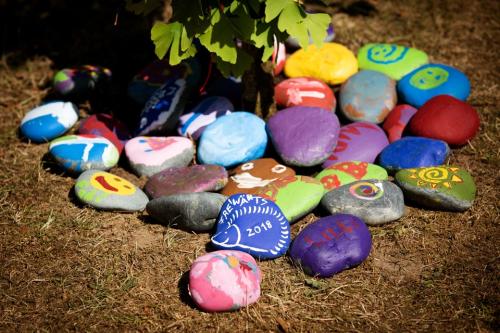
And the children themselves? What do they think of FREIWÄRTS? “Better than regular school, much better,” Mona says. She is doing much better here than at her previous school. Another girl drives an hour each way just to go to school here. “Actually, I really like school,” I hear from off to the side. “Why actually?” a little boy asks indignantly. “Well, sleeping in is even better.” Can’t argue with that… 😉
Senior Communication Experts
So what’s my conclusion after two days at FREIWÄRTS? They’ve created an amazing community here, and it continues to evolve. The children interact with each other a lot, much more than I remember from my time at school. They fool around (after all, that’s part of growing up!), but they also share ideas, discuss things with each other, are cheerful and active. During the two days I learned a great deal from these little people – and I have a new goal: I want to be able to communicate as well as they do. And when I get together with friends who are usually always glued to their cell phones, I’ll ask them to put the devices away. For a new sense of freedom.
Is the FREIWÄRTS system superior?
How does the system at FREIWÄRTS compare to that of a regular school? When a student graduates from FREIWÄRTS, he or she earns a secondary school diploma after eight years – just like at other schools. Then there are the social skills that they have acquired over the years. This gives them a decisive advantage over students at a “normal” school. The current school system has come under fire recently for many reasons (see the article “Learning Has to Become Awesome” – Of Finger Games and Laptops”). The FREIWÄRTS school, where children can learn completely independently and at their own pace, where they can realize their full potential, could be a solution.
Why Did We Write This Article?
Here at QUADRO, we believe it is extremely important for us to get a feel for what’s on children’s minds, what challenges and interests them, and what they enjoy. We then incorporate this knowledge into our products so that children grow up in the most natural way possible – and parents can be sure that they are doing exactly the right thing for their children.
Read about even more ways to learn in our blog article “Learning Has to Become Awesome” – Of Finger Games and Laptops.
↑ Editor’s note: All of the names have been changed to protect privacy.
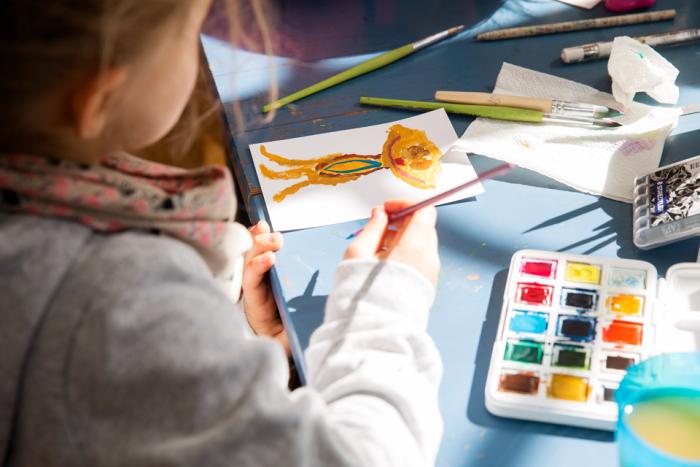
Komentarai